Shopify vs Squarespace: Which Platform Reigns Supreme?
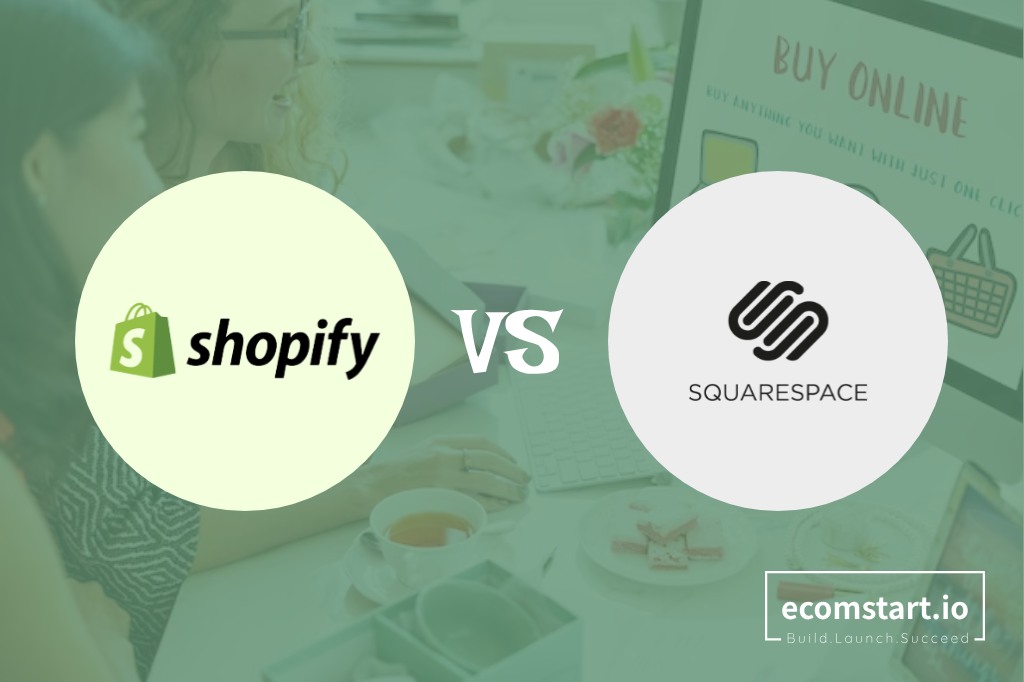
Well, your brilliant idea for an online business is going to bring you a breeze and you’re just about to launch your own website. But, here’s the thing – you’re stuck between two popular website-building platforms: Shopify and Squarespace. Both are well-known eCommerce platforms.
There is no need to unnecessarily complicate the already complex process of making such a choice. In this article, we’re going to dive deep into the debate. Let’s compare Shopify vs Squarespace, decide which is better, Shopify or Squarespace, and explore all aspects of their functionality, ease of use, pricing, and more. So, if you’re ready to find the perfect platform to bring your online business dreams to life, keep on reading.
1. Key differences at a glance: Shopify vs Squarespace
| Shopify | Squarespace | |
| Definition | A solution for making an online store | A solution for building and maintaining content-based websites |
| Rating | 4.5/5 (6276 votes from GetApp) | 4.6/5 (2913 votes from GetApp) |
| Pricing | From $29 to $299/month | From $16 to $49/month |
| Target audience | Businesses of all sizes | Individuals and small businesses |
| Design & customization | 180+ free & premium themes | 160+ free themes |
| Ease of use | Drag-and-drop website builder with intuitive navigation | A slight learning curve for beginners |
| eCommerce features | Comprehensive eCommerce features | Basic eCommerce capabilities |
| Marketing tools | Advanced marketing features | Basic marketing tools |
| Apps & integration | Extensive app store, wide-range integrations | Limited available apps, integration with popular services and platforms |
| Scalability | Can handle large volumes of traffic and sales | Can handle moderate traffic |
| Pros | Power eCommerce functionality Easy to customize Helpful setup tutorials Automatic updates and backups | Powerful blogging features Unlimited bandwidth and storage Integrated design options Affordable pricing |
| Cons | Limited design flexibility Additional costs | Less intuitive customized options Limited eCommerce features Fewer apps and extensions |

Shopify is a popular all-in-one eCommerce platform that allows businesses to create and manage their online stores. It provides a range of features and tools, such as customizable themes, product management, secure payment options, and marketing integrations. With Shopify, users can easily set up their online stores without any coding or design expertise.
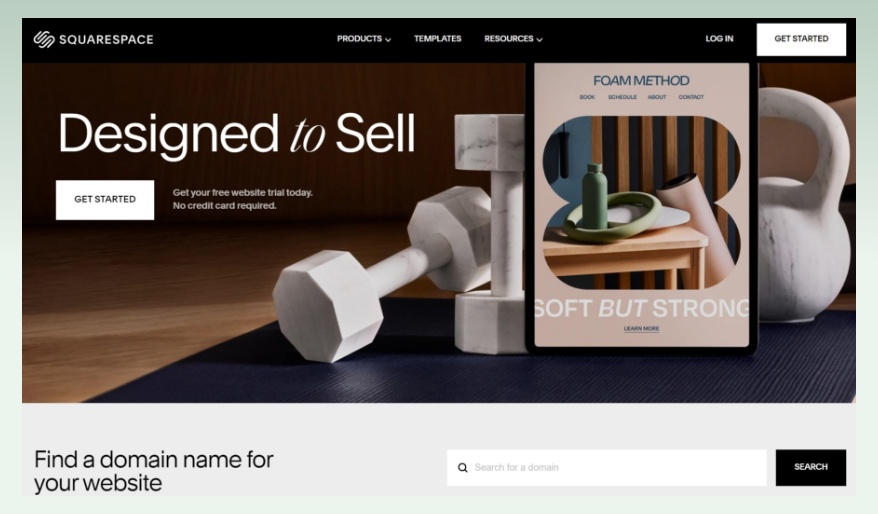
On the other hand, Squarespace is a website builder that caters to various types of websites, including eCommerce. It offers visually stunning templates, a user-friendly interface, and extensive customization options. It also provides tools for managing inventory, processing payments, and analyzing site performance.
The main difference between Shopify and Squarespace lies in their primary focus. While both platforms offer eCommerce solutions, Shopify is specifically designed to support online stores and prioritize commerce functionalities. Meanwhile, Squarespace is a broader website builder that includes eCommerce capabilities as part of its offering.
>>> Learn more: Shopify vs Gumroad: Which one comes out on top?
2. Shopify vs Squarespace: A deep dive comparison
Now, let’s compare in detail whether – is Shopify better than Squarespace, or who wins the battle of Shopify vs Squarespace for eCommerce.
2.1. Pricing
2.1.1 Monthly fee
Shopify offers multiple pricing tiers, from the basic package suitable for new businesses to more advanced packages catering to scaling and large businesses. There is also a free trial, and allows you a $1 payment for the first month.
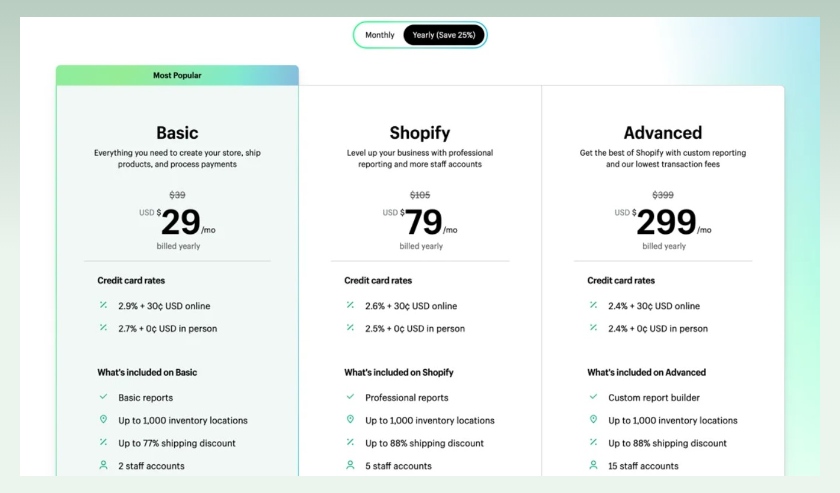
If you pay for the subscription fees in the annual package, the price will respectively be:
- Basic: $29/month
- Shopify: $79/month
- Advanced: $299/month
Squarespace offers four plans, and all of them are premium. With its flat-rate pricing structure, Squarespace can be more budget-friendly for small businesses. Among the four options, only the lowest-cost plan does not have eCommerce features.

Squarespace monthly fee – if you pay on an annual package, will be:
- Personal: $16
- Business: $23
- Basic Commerce: $27
- Advanced Commerce: $49
2.1.2. Transaction fee
Shopify: Regarding payment methods, Shopify partners with over 100 payment gateways. The platform has built-in payment processing through Shopify Payments, which allows zero transaction fees if you use it as your processor. In case you opt to use a third-party payment processing, you will be charged 2% for Shopify’s Basic plan.
Squarespace: Its payment method is limited to Stripe, PayPal, Apple Pay, and Afterpay and Clearpay for installment payments. The platform charges a 3% transaction fee on all sales if you use the Business plan. Squarespace doesn’t charge any transaction fees on its two eCommerce plans – Basic Commerce and Advanced Commerce.
2.1.3. Additional fees
Shopify: The platform does charge an extra fee for some features, such as the use of third-party payment gateways, external shipping carriers, and buying premium themes or apps from the Shopify marketplace.
Squarespace: The platform does not charge additional costs for using external payment gateways or shipping carriers. However, to use some of the advanced functionalities, you may need to install add-ons or subscribe to the higher-level plan.
The winner is: Squarespace easily overrides in the area of pricing as their plan is reasonably priced.
2.2. Design & customization
Shopify: There are more than 180 professionally designed free & premium Shopify themes to choose from at the Shopify Theme Store. The premium options price starts at $140 and the basic set of features includes full-bleed content, image animation, and video backgrounds. In addition, you can take advantage of the library with various royalty-free stock images.
On the other hand, some themes don’t have navigation bars that scroll down with you, and it is a challenging thing to correct. Keep in mind that Shopify’s customization flexibility is designed to bring out the best representation of your online store and display it as dynamic and interesting as possible. Therefore, users who want a more creative touch for their store will find Shopify a little bit limited.

Squarespace: The platform offers more than 160 themes, and all of them are free. In addition, these mobile responsive themes are not restricted to a single industry but can be adapted to fit a variety of businesses.
A large number of Squarespace templates are intended in the first place for creative users, who need to blog or create a portfolio for their art, music, or photography. Hence, you will see lots of nice visuals that will slide in and out with changing images and text while the user scrolls a site.
And the Squarespace templates can be even more enriched through built-in connections with Unsplash and Getty images. These integrations open up a very easy way for your website to include stock images taken from either service. When you upload a picture on a page, you can just use a search box to find something suitable on any of them.

The winner is: Squarespace, which nails it between the line of design-oriented purposes and effortless simplicity.
2.3. Ease of use
Shopify: The platform offers a drag-and-drop website builder with intuitive navigation. Straight from the Shopify dashboard, merchants can set up an online store immediately and without many stumbling blocks. The user-friendly interface is also streamlined, and there are no coding knowledge requirements.
Squarespace: While also offering a drag-and-drop interface, Squarespace is more design-focused. Creating visually appealing websites is easy but might take a slight learning curve for beginners. With Squarespace, you can add HTML using a Code Block, and CSS using their CSS Editor.
The winner is: Shopify, with its clean template editor and novice-friendly dashboard.
2.4. eCommerce features
Shopify: Shopify is an eCommerce-centric platform with an extensive option of features. Those functions range from inventory management, payment gateways, to abandoned carts recovery statistics, and automated shipping rates, etc. It is specially tailored to meet the needs of online selling.
Squarespace: Squarespace offers eCommerce capabilities, though its list of features may be simpler than its rival platform. These are features like product catalogs, inventory management, support for different variants of products, and options for selling a mix of digital and physical products.
2.4.1. Product types & product presentation
Physical, digital, and service products can be sold on both platforms. Nevertheless, you have to install a third-party app, like Digital Downloads, to use it for digital products selling on Shopify. On Squarespace, you are provided with all the primary marketing tools you need for selling any kind of product.
In terms of the product variants, if you have more than one variation of the same product (e.g., different colors, sizes, and materials), both Shopify as well as Squarespace will be as good.
2.4.2. Sales channels
Omnichannel selling ability allows merchants to sell their products across social media platforms and online marketplaces.
Straight from its home page, Shopify can be integrated directly with other sales channels and sell via Facebook Marketplace, Instagram Ads, TikTok Ads, and even Amazon, eBay, and Walmart. What’s particularly ideal about using Shopify is that you can utilize its Buy Button feature for selling across platforms without much effort.
Meanwhile, Squarespace is still designed especially for basic online selling. Whether you are wondering about Shopify or Squarespace for small businesses, this is your answer. Currently, Squarespace only gives you access to Instagram. It can integrate with Amazon, but only for tracking purposes – you can’t sell on Amazon directly from your Squarespace store.
2.4.3. Payment options
Shopify understands that the wider range of payment types you have accepted, the more money you’ve made. It supports all the leading payment processors such as Amazon Pay, Square, and also crypto, while more than 100 other payment options are available.
What’s more, is that Shopify provides merchants with built-in fraud prevention tools. You can rest assured about your store and your customer’s data security.
On the contrary, Squarespace will be limited in payment options to the gateways it supports. We have only three options – PayPal, Stripe, and Apple Pay. There are also fraud prevention features, but at a basic level that you can find on most other platforms.
2.4.4. Shipping options
Shipping with Shopify is a breeze. With direct USPS, UPS, DHL, and FedEx integrations, Shopify allows sellers to calculate real-time carrier rates, provides printable shipping labels, and takes advantage of major shipping discounts all within the platform. The platform also supports dropshipping via apps, making it ideal for dropshippers.
Compared to Shopify, Squarespace shipping and delivery options are much more limited. It is restricted to basic shipping features, with no built-in shipping integrations. The plus point is that Squarespace now interacts with USP to display carrier shipping rates. You can customize the shipping cost concerning the country you are shipping to or by weight.
2.4.5. Monitoring and analytics
On the analytical side, Shopify is also considered to be well-equipped. Track customer behavior and you’ll have a full context of who is visiting your store. You’ll also be notified via email when your stock levels are low. It is wise to integrate your site with Google Analytics to have more powerful analytics tools.
Squarespace offers its own analytics software called Squarespace Analytics. You are tracking sales revenue, the total amount of orders, conversion rates, and customer behavior. However, it fails to gain points because of the lack of stock monitoring alerts provided.
The winner is: Shopify falls among a group of the most comprehensive eCommerce website builders currently existing, so naturally it wins this catalog.
2.5. Marketing tools
Shopify: Shopify offers advanced tools like abandoned cart recovery, email marketing, and integration with social platforms. Other built-in marketing tools include SEO features, discount codes, gift cards, product reviews, etc. In addition, various marketing channels are provided as well, including customizable landing pages to attract customers.
Squarespace: Squarespace offers some marketing tools like SEO features, social sharing, and a metrics dashboard. They also have built-in integrations with popular social media platforms. While a Squarespace website provides essential marketing tools, it might not be as eCommerce-centric as Shopify.
The winner is: Shopify has a higher marketing tool functionality than Squarespace to expand your e-store.
2.6. App & integrations
Shopify: There are over 8000 apps from the Shopify App Store. There are many types of apps for different purposes e.g. marketing, inventory management, customer support, and so on. Shopify works with numerous third-party apps and integrates with accounting systems, email marketing providers, major shipping carriers, and different social media networks.
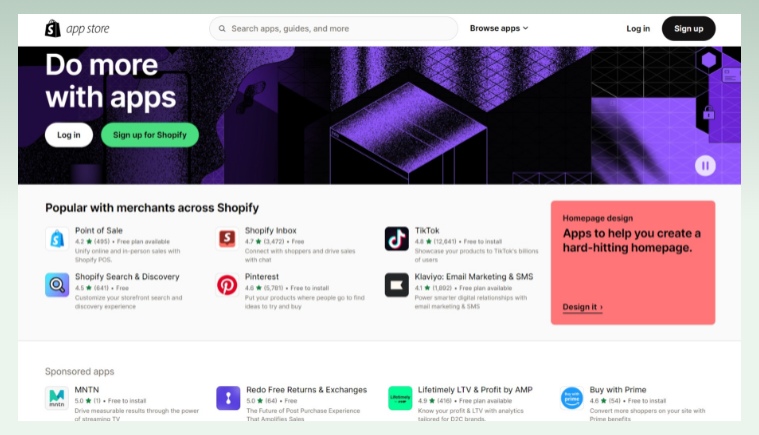
Squarespace: There are only over 30 applications to choose from, which cater to basic requirements such as accounting, shipping, and order management. Squarespace makes use of integrations with services like Google Analytics, MailChimp, and social media platforms, but these integrations are few compared to those of Shopify.
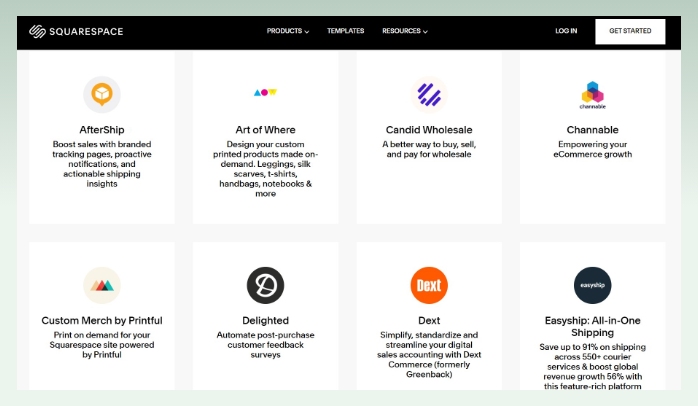
The winner is: Shopify wins in terms of apps and integration options, as it offers a more extensive app store and integration possibilities.
2.7. Scalability
Shopify: Shopify is one of the most scalable eCommerce platforms that will help to handle heavy volumes of traffic and sales. The platform is also made for global eCommerce, it supports multiple currencies, global payment gateways, along with localization features. It provides the latest features that are capable of supporting online stores with high demand.
Squarespace: Squarespace is typically a suitable solution for small to mid-sized businesses. It can serve up to a moderate load of traffic, but the challenges arise as scalability increases. It may cater to international audiences, but there is a lack of tailoring attributes for global eCommerce that we get in Shopify. Therefore, larger eCommerce operations might find it restrictive.
The winner is: Shopify, as it can definitely grow with your business.
2.8. Customer support
Shopify: Shopify offers 24/7 support through live chat and phone options. It also comes with a detailed knowledge base, customer forums, and webinars to make you get acquainted with the platform. For any billing issues, you can submit those through emails.
Squarespace: Squarespace has fewer support options compared to the abundance of Shopify’s support. It, however, lacks phone support but has live chat support from Monday to Friday and 24/7 email support, webinars, a knowledge base, and customer forums.
The winner is: Shopify is undoubtedly the winner here. Its 24/7 live chat support solves all the website builder-related issues immediately and without much trouble.
3. Shopify vs Squarespace: Who holds the winning hand?
3.1. Pros and Cons of Shopify
Pros:
- Robust eCommerce functionality
- Extensive app store
- Scalability
- SEO-friendly
Cons:
- Additional cost
- Limited design flexibility
Choose Shopify if you:
- Are businesses of all sizes that plan to scale
- Sell and ship products to individual customers
- Frequently sell products on other social platforms and marketplaces
- Earn enough revenue to take advantage of reduced fees and discounts at Shopify’s higher pricing plan
3.2. Pros and Cons of Squarespace
Pros:
- Beautiful templates and designs
- Integrated blogging tools
- Mobile-responsive designs
- Affordable
Cons:
- Less eCommerce focused
- SEO limitations
- Can’t handle high traffic
Choose Squarespace if you:
- Are individuals, startups, and small businesses
- Frequently booking appointments
- Earn revenue from memberships or exclusive content.
- Want a content-oriented website
3.3. Our verdict
Then, is Shopify or Squarespace better?
Shopify does give you an advanced feature set that has been tailored strictly for eCommerce. Because of this, Shopify will be suitable for businesses that are looking to run their online stores smoothly and successfully. Unlike it, Squarespace may be a good choice for those who want to have an attractive website with eCommerce inclusion as an extra feature.
Squarespace is the more advanced option for the design with more comprehensive built-in tools. While Shopify also offers a good-looking display of visuals, nevertheless, Squarespace has the upper hand when it comes to design and appearance. The large number and superb quality of templates of Squarespace, make Shopify’s preset designs appear less attractive than Squarespace’s.
After all, the winner is Shopify. Squarespace offers great design options and is more budget and beginner-friendly. However, Shopify tops all of them in terms of eCommerce functionalities, scalability, and app integrations. Since running an online store with advanced functionalities, many customization options, and the prospect of scaling up is your primary concern, Shopify must be worthy of your consideration.
💡 If you’re thinking about other eCommerce platforms besides Shopify, it’s a good idea to look into Shopify vs other eCommerce platforms. This can introduce you to new options and help you find the platform that best meets your needs.
4. Conclusion
In conclusion, when it comes to choosing between Shopify vs Squarespace for your online business, it is important to carefully consider your specific needs and requirements. Both platforms offer unique features and benefits that can help you create a successful online store. Indeed, Shopify is addressed to online selling, while Squarespace is a more suitable solution for building and maintaining a website with a lot of content.
If you are seeking a comprehensive business guide to assist you in setting up and managing your eCommerce venture, eComStart.io serves as an excellent resource. By utilizing eComStart expert guidance and leveraging the capabilities of either Shopify or Squarespace, you can maximize your chances of running a profitable and thriving online business.


